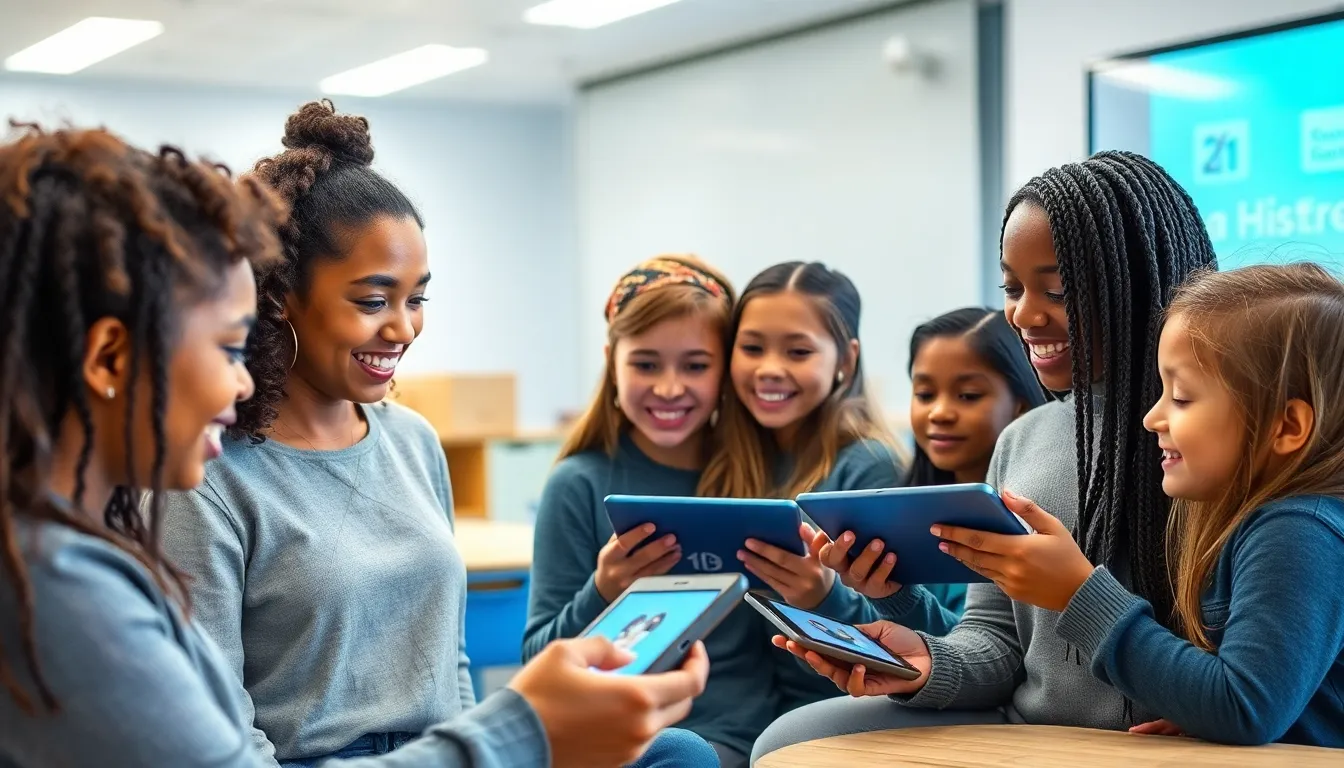Imagine a classroom where textbooks come to life, and students can explore ancient civilizations without leaving their desks. Augmented reality education apps are turning this dream into reality, making learning as exciting as a treasure hunt. These innovative tools blend the digital world with the physical, creating interactive experiences that captivate even the most reluctant learners.
Table of Contents
ToggleOverview of Augmented Reality Education Apps
Augmented reality education apps redefine traditional learning methods. By integrating digital information with the real world, these apps enhance student engagement significantly. Users can interact with three-dimensional models, visualizing complex concepts more clearly.
Educators across various subjects leverage such tools to foster curiosity. In subjects like biology, students can examine the human body in detail through lifelike models. Historical events come alive as students visualize key moments in augmented settings.
Specific apps, such as Google Expeditions, provide guided virtual field trips, making global exploration accessible from the classroom. Applications like Merge Cube allow learners to manipulate virtual objects, encouraging hands-on interaction.
Schools report increased participation and improved retention rates after incorporating augmented reality into their curriculum. Data shows that 73% of students feel motivated when using these technologies.
Teachers appreciate the flexibility of augmented reality apps, as they can tailor content to meet different learning styles. Students typically benefit from visual stimuli that enhance their understanding of complex topics.
Overall, <a href="https://triovd.com/augmented-reality-in-museums“>augmented reality education apps create immersive experiences that bridge the gap between theoretical knowledge and practical application. By fostering an engaging learning environment, these tools also cater to diverse learner needs, promoting inclusivity in education.
Benefits of Augmented Reality in Education

Augmented reality (AR) education apps offer significant advantages, transforming conventional learning into dynamic experiences.
Enhanced Learning Experiences
Students grasp complex subjects through interactive three-dimensional models, which improve comprehension. Immersive environments allow learners to visualize historical events or explore intricate biological structures. Engaging with AR content aids memory retention by linking theoretical concepts to practical applications. Such experiences cater to various learning styles, empowering educators to provide tailored instruction. As learners navigate through these digital landscapes, curiosity flourishes, enriching their educational journey.
Increased Engagement and Motivation
Research reveals 73% of students feel motivated while using AR technologies. This heightened enthusiasm transforms the classroom atmosphere. Students actively participate in tasks that promote collaboration, enhancing peer interaction. Teachers frequently notice increased retention rates, as learners become more invested in their studies. Tailoring lessons to include AR tools captures students’ attention, encouraging them to explore subjects further. By fostering a captivating learning environment, augmented reality encourages lifelong curiosity and a passion for knowledge.
Popular Augmented Reality Education Apps
Several augmented reality education apps enhance learning experiences by combining digital information with real-world interactions. These apps engage students and promote understanding across various subjects.
App 1: Overview and Features
Google Expeditions enables virtual field trips, allowing students to explore historical sites and natural wonders. With a large library of 360-degree images and videos, it provides immersive experiences. Students can navigate through the content with ease, gaining insights that traditional methods can’t offer. Educators appreciate its user-friendly interface, making lesson planning straightforward. The multi-user functionality encourages collaborative exploration among students.
App 2: Overview and Features
Merge Cube offers a hands-on learning experience through augmented reality. Users can interact with 3D models by holding the cube, bringing subjects like biology and astronomy to life. This engaging format captivates students’ attention, helping them visualize complex concepts. Content creators can customize experiences, tailoring lessons to specific learning objectives. Teachers utilize Merge Cube in various subjects, benefiting from its versatility and engagement potential.
App 3: Overview and Features
QuiverVision combines coloring with augmented reality, transforming student artwork into interactive experiences. The app allows learners to color in printed images, which then animate on screen when viewed through a device. This unique approach fosters creativity and enhances engagement with educational content. Educators incorporate QuiverVision into art and science lessons, promoting interdisciplinary learning. Students gain motivation as they witness their creations come to life.
Challenges and Considerations
Augmented reality education apps face several challenges that impact their effectiveness in learning environments. Addressing these challenges is essential for maximizing the benefits of AR in education.
Technical Limitations
Technical limitations hinder the seamless integration of AR apps in classrooms. Many devices lack the necessary processing power to run complex AR applications effectively. Users often experience lag or poor graphics, impacting the immersive experience that AR is designed to provide. Connectivity issues can disrupt interactive sessions, making it difficult for educators to maintain engagement. Additionally, not all schools have access to the latest technology, creating disparities in availability and usability across different educational institutions.
Accessibility Issues
Accessibility issues present significant barriers to the widespread adoption of AR education apps. Some students may not have access to compatible devices, limiting their ability to participate in AR-enhanced learning. Financial constraints can prevent schools from acquiring the necessary hardware and software. Many apps may not account for diverse learning needs, affecting engagement among students with disabilities. Furthermore, language barriers can pose additional challenges, as many AR applications primarily cater to English-speaking users, potentially alienating non-native speakers.
Future Trends in Augmented Reality Education
Emerging trends reveal a promising future for augmented reality (AR) in education. Increased investment in AR technologies fosters innovation, allowing developers to create more dynamic and user-friendly applications. Personalized learning experiences enhance student engagement as educators can tailor content to fit individual learning styles and preferences.
Gamification surfaces as a compelling trend, drawing students into interactive experiences that boost motivation and enjoyment. Institutions that integrate AR into the curriculum find students become more invested in their learning. Schools increasingly utilize AR tools to simulate real-world scenarios, helping learners connect theoretical concepts with practical applications.
Cross-disciplinary collaboration gains traction with AR apps bridging gaps between subjects. For instance, integrating history and science through immersive AR experiences cultivates a holistic understanding of complex topics. Additionally, the rise of cloud-based AR solutions enables seamless updates and access to a broader range of educational resources.
Student assessments evolve with the implementation of AR, providing real-time feedback that facilitates immediate improvement. Teachers report that interactive assessments enhance retention, as students actively engage with content instead of passively consuming information.
Accessibility continues to be a priority, directing developers to create solutions that cater to diverse learner needs. Focus on inclusivity ensures that all students, regardless of abilities, can benefit from AR technologies. As augmented reality continues to advance, its integration in education promises to transform how students learn and interact with the world around them.
Augmented reality education apps are reshaping the learning landscape by creating immersive experiences that captivate students. These tools not only enhance engagement but also facilitate deeper understanding of complex subjects. As educators embrace AR technology, they unlock new pathways for exploration and collaboration, fostering a love for learning that can last a lifetime.
While challenges such as accessibility and technical limitations persist, ongoing advancements promise to make AR more inclusive and effective. The future of education looks bright with AR at the forefront, driving innovation and transforming how students interact with knowledge. By harnessing the power of augmented reality, educators can inspire curiosity and creativity, ultimately paving the way for a more dynamic learning environment.


